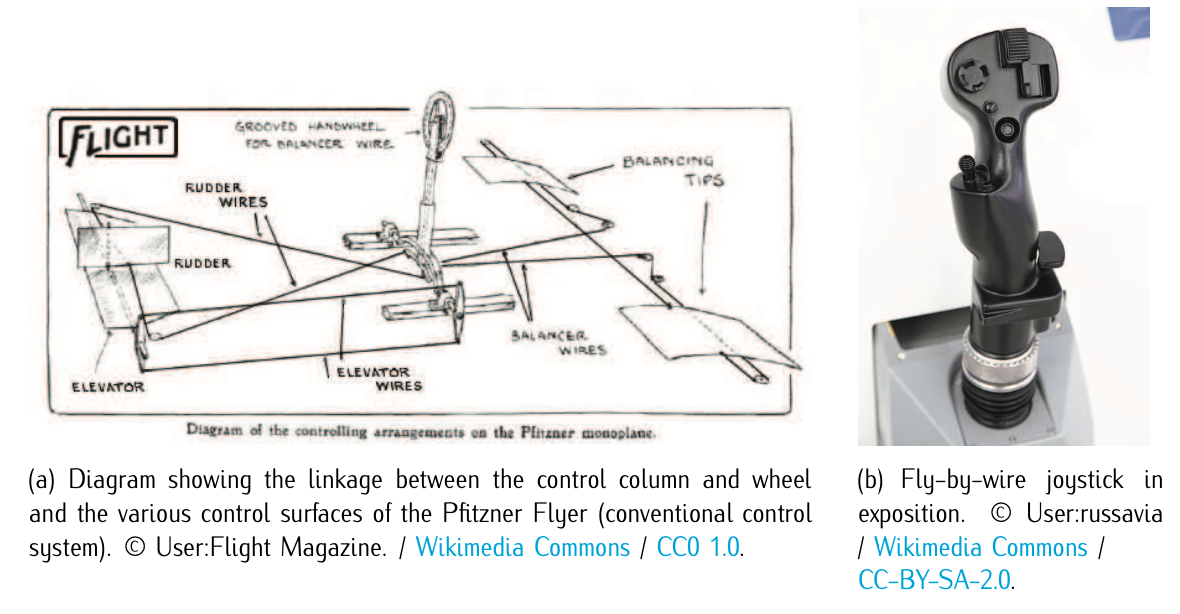5.2.4: Flight control systems- Fly-By-Wire
- Page ID
- 78134
Fly-by-wire Wikipedia [7] is a system that replaces the conventional manual flight controls of an aircraft with an electronic interface. The movements of flight controls are converted to electronic signals transmitted by wires (hence the fly-by-wire term), and flight control computers determine how to move the actuators at each control surface to provide the adequate response. The fly-by-wire system also allows automatic signals sent by the aircraft’s computers to perform functions without the pilot’s input, as in systems that automatically help stabilize the aircraft.

Figure 5.18: Flight control system: conventional and flight by wire.
Mechanical and hydro-mechanical flight control systems are relatively heavy and require careful routing of flight control cables through the aircraft by systems of pulleys, cranks, tension cables, and hydraulic pipes. Both systems often require redundant backups to deal with failures, which again increases weight. Also, both have limited ability to compensate for changing aerodynamic conditions. The term fly-by-wire implies a purely electrically-signaled control system. However, it is used in the general sense of computer- configured controls, where a computer system is interposed between the operator and the final control actuators or surfaces. This modifies the manual inputs of the pilot in accordance with control parameters.
Command: Fly-by wire systems are quite complex; however their operation can be explained in relatively simple terms. When a pilot moves the control column (also referred to as sidestick or joystick), a signal is sent to a computer through multiple wires or channels (a triplex is when there are three channels). The computer receives the signals, which are then sent to the control surface actuator, resulting in surface motion. Potentiometers in the actuator send a signal back to the computer reporting the position of the actuator. When the actuator reaches the desired position, the two signals (incoming and outgoing) cancel each other out and the actuator stops moving.
Automatic Stability Systems: Fly-by-wire control systems allow aircraft computers to perform tasks without pilot input. Automatic stability systems operate in this way. Gyroscopes fitted with sensors are mounted in an aircraft to sense movement changes in the pitch, roll, and yaw axes. Any movement results in signals to the computer, which automatically moves control actuators to stabilize the aircraft to nominal conditions.
Digital Fly-By-Wire: A digital fly-by-wire flight control system is similar to its analog counterpart. However, the signal processing is done by digital computers and the pilot literally can "fly-via-computer". This also increases the flexibility of the flight control system, since the digital computers can receive input from any aircraft sensor, e.g., altimeters and pitot tube. This also increases the electronic stability, because the system is less dependent on the values of critical electrical components in an analog controller. The computers sense position and force inputs from pilot controls and aircraft sensors. They solve differential equations to determine the appropriate command signals that move the flight controls to execute the intentions of the pilot. The Airbus Industries Airbus A320 became the first airliner to fly with an all-digital fly-by-wire control system.
Main advantages: Summing up, the main advantages of fly-by-wire systems are:
-
decrease in weight, which results in fuel savings;
-
reduction in maintenance time (instead of adjusting the system, pieces are simply changed by new ones, so that maintenance is made more agile);
-
better response to air gusts, which results in more comfort for passengers;
-
automatic control of maneuvers (the systems avoid the pilot executing maneuvers with exceed of force in the controls).


